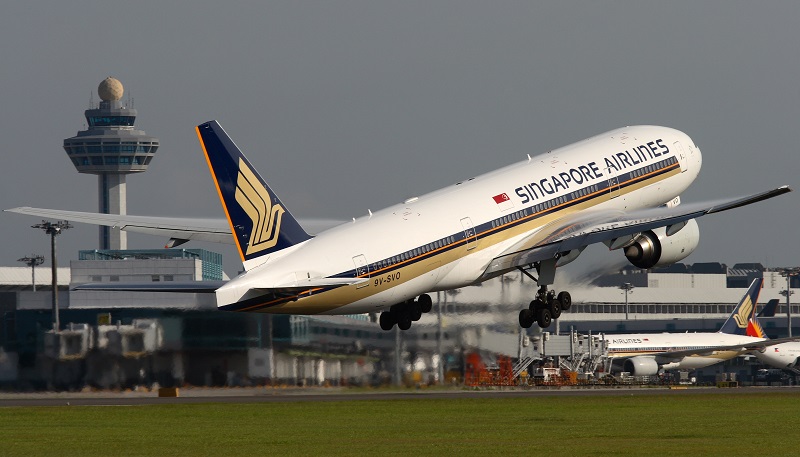
Steady growth in the number of commercial aircraft in Asia-Pacific means the regions demand for aviation lubricants is also rising and should continue to do so in coming years. Industry insiders say the increase in lube demand will be tempered by a shift towards higher quality lubes.
Airbus and Boeing, the worlds leading commercial aircraft manufacturers, predict that global economic growth, further market development in emerging countries and increased air traffic will lead to a significant number of orders and deliveries of aircraft for Asia-Pacific through the year 2034.

Photo: Sigapore Airlines
Commercial aircraft sales for the Asia-Pacific region indicate that demand for aviation lubricants will rise in the future.
The projected growth in Asia-Pacific aircraft sales is a good indicator for an increase in the usage of aviation lubricants in the region, Stphane Cicolella, lubricants general manager at Shell Aviation, told Lube Report Asia. However, we must bear in mind that some of the high-performing lubricants used in the newer aircraft last much longer than the onesusing older lubricant technologies. These products create added value for the customers and help reduce maintenancechallenges.
Paul Fridman, marketing manager for Eastman Aviation Solutions, agreed. Oil consumption varies by aircraft based on engine type, so there might not be a direct correlation as older aircraft – [which often have] higher oil consumption – are retired and newer aircraft take their place.
During 2015, Airbus delivered 232 commercial planes to customers across Asia-Pacific, which represents 44 percent of its total output of 635 aircraft for the year. Currently, the company has identified 1,942 additional planes on order for Asia-Pacific carriers, which is 32 percent of the units on its books (excluding undisclosed and VIP orders). Not to be outdone, Boeing in 2015 handed over 275 new jets to customers in the region, which was 36 percent of the 762 units it delivered. At year end, Boeing had another 1,266 jets on its order books for the regions carriers, or 27 percent of its backlog.
Thats just the start. In its recent Global Market Forecast for the years 2015 to 2034, Airbus estimated Asia-Pacific will need to buy around 12,600 new commercial jets over the next two decades, with 37 percent of these destined to replace older and retired equipment and 63 percent for fleet growth. Similarly, Boeing forecasts 14,330 new aircraft will be needed in Asia-Pacific in that period, in its Current Market Outlook 2015-2034 report.
Not only is Asia seeing increases in the number of commercial aircraft in use, the varieties of planes in use are also increasing. According to Eric Piveteau, general manager of Nyco Synthetic Lubricants, different planes will have their own lubricant specifications. This could lead to a proliferation of lubricants needed by fleet operators, unless lubricant marketers help prevent it. The added value of lubricants manufacturers will be to design products matching as many specifications as possible, in order to avoid airlines using different lubricants for the same kind of applications on different aircraft.
At the moment, there are no aviation lubricants manufacturers for commercial aircraft within Asia-Pacific, said Piveteau, with only PetroChina and Sinopec manufacturing products for military purposes. Aviation lubricants are instead imported from Europe and U.S.-based suppliers, and since most OEMs are outside of Asia-Pacific, Fridman believes this will benefit the suppliers, as they influence oil approvals, associated suppliers and product offerings available to Asian aviation operators.
The major lubricant/oil suppliers are very well established, and there remains very significant barriers to entry for new suppliers, given the time and resource investment required for new product approvals, said Eastman Aviations Fridman. Shell Aviation, for instance, distributes engine oils and other lubricants for turbine- and piston-engine aircraft to Asia-Pacific from its division in Singapore.
Sources expressed differing opinions on the readiness of supply chains to handle greater demand for aviation lubricants in Asia-Pacific.
Given that aviation lubricants are made to high specifications, an increase in demand has to be properly planned and delivered through proper forecasting and projections, said Cicolella of Shell Aviation.
Nycos Piveteau said supply chains are ready. The existing capacities of the manufacturers of lubricants for commercial aviation are fully reliable and in sufficient quantity. Also, the majority of these products have a long shelf life, meaning they can be stored easily for a long time.
At Eastman Aviation, Fridman is not so sure. The implications of this increase in demand can place pressure on securing guaranteed supply of raw materials used in the manufacture of aviation base stocks.